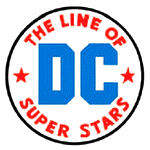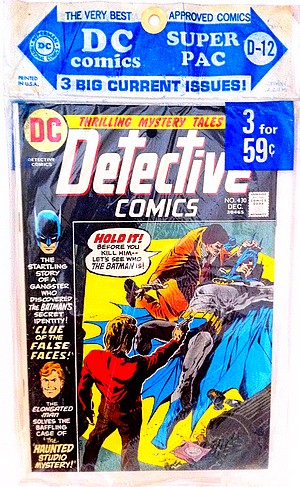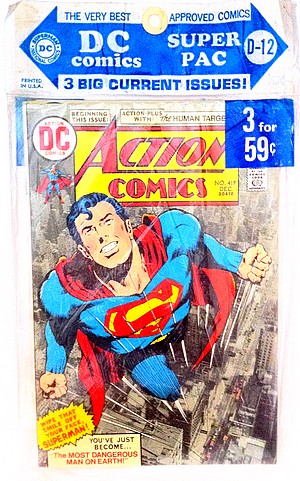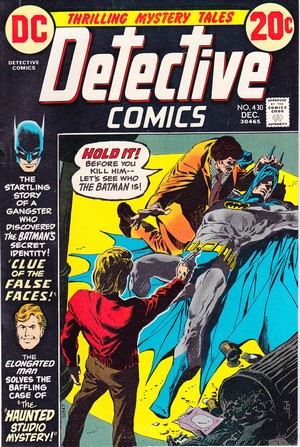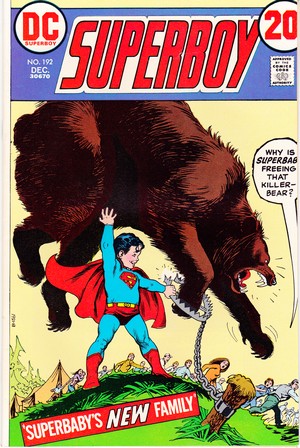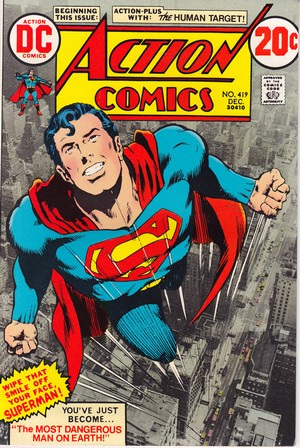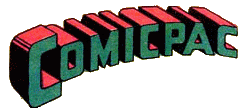DETECTIVE COMICS, SUPERBOY & ACTION COMICS INSIDE THE |
|||||
 |
|||||
|
|||||
| Generating story interest
therefore hinged almost entirely on the plot as the
adversaries offered little in comparison to a Joker or a
Riddler. But Frank Robbins often lived up to the
challenge, and "Clue of the False Faces" is a
real gem: after receiving a blow to the head, Batman
suffers a spell of partial amnesia - and can't remember
who the person underneath the mask and cowl is. An
interesting starting point is handled extremely well
right up to the end and is a story well worth reading -
sadly, not collected to this day. Frank Robbins
(1917-1994) would soon end his lenthy run (both as writer
and as writer/artist) on Batman in Detective Comics
after five years; issue #436 would be his last. Bob Brown
(1915-1977), the co-creator of Thalia al Ghul (together
with Dennis O'Neil), had a lenghthy spell on Detective
Comics between 1968 and 1973. The backup character of this issue of Detective Comics is the Elongated Man, created in 1960 by John Broome and Carmen Infantino but heavily pushed by editor Julius Schwartz who wanted a new supporting character for the Flash. Described in this issue in an editorial blurb as "Ralph Dibny - the only superhero whose identity is known", the Elongated Man is actually more of a detective than a superhero in the classic sense. However, the plot of "The Haunted Studio Mystery" is - forgive the pun - so far stretched that the bad guys really ought to be jailed for their stupidity rather than their lawbreaking. Thankfully, the 15 pages of Batman in Detective Comics #430 are so excellent that they easily outweigh 8 pages of strung out cheesy nonsense. |
|||||
|
|||||
| The story (which has no
credits in the comic book itself) is somewhat typical of
the very sanitized content some DC titles of the early
1970s featured: The only survivor of a subterranean
Atlantean civilization reaches the surface and has
hypnotized Jonathan and Martha Kent into aiding him in
his nightly workings, which have the goal of screening
Smallville from any sunlight - which he superstitiously
fears. However, Superboy frees his parents from the
hypnotic spell, thwarts the plan, cures the Atlantean's
fear of sunlight - and even finds a family who will adopt
him much like he himself was. Superbaby takes the concept of Superboy even further back as Superman is portrayed as a toddler. First appearing in Superman #53 in 1948, the Superbaby stories were almost entirely written with humorous undertones. In Superboy #192 this is combined with a message of protecting wildlife as the "Baby of Steel" makes friends with a family of bears and saves them from two poachers. All of this virtually screams CHEEEEESY today, but lo and behold Leo Dorfman's story and Murphy Anderson's art still work today and actually provide some good fun reading even for those who don't really care for any superhero family concepts - also helped perhaps that unlike what is shown on the cover, Superbaby does not actually wear a kid's fancy dress party version of the Superman costume in the story. Perhaps not actually a gem like some other comics that were packaged into the middle of these bags (the Superboy story is entertaining but slightly bland) Superboy #192 nevertheless provides a (surprisingly) good entertaining read. |
|||||
|
|||||
| At the same time a
small-time crook fishes two shoes and a gun out of the
Metropolis river which both seem to have uncanny powers
which he uses to cause destruction and rob banks.
Superman finds a way to stop all of this by eliminating
the source of all of these strange happenings: cosmic
rays diverted to Earth by some residue on the lens of the
newly installed telescope. In the backup story, readers are introduced to Boston based Christopher Chance who, as "The Human Target", uses his disguise techniques and physical fitness and mental alertness to stand in for individuals who have reason to fear for their life. In this adventure, Chance foils an attempt made on a train to murder the owner of a chemical corporation. The Superman story of Action Comics #419 is not without entertainment value but does show that comic book science often requires complete suspension of disbelief - and even then certain things just don't make sense. The fact that the story was penned by Cary Bates with the "technical assistance of Pete Simmons, Director of Space Astronomy, Grumman Aerospace Corporation" does, however, make for an amazingly accurate design of a reusable spacecraft which highly resembles a Space Shuttle - a good eight years before its launch in real life. But the real point of interest with Action Comics #419 lies with the backup feature anyway. The second features which appeared in Action Comics during the Bronze Age - Green Arrow & Black Canary, Atom, Human Target - were responsible for much of the appeal of the title, making it a must-buy for many who weren't Superman fans at all (Kingman, 2013), and the Human Target (created by Len Wein and Carmine Infantino and making his first appearance in this issue of Action Comics) provided some non-superhero interest which was close to the spi-fi genre. He left Action Comics after issue #432 in February 1974 and moved on to become the backup in Detective Comics until 1982 (with a few appearances in Brave and the Bold). He then switched to Batman until late 1982. In 1999 he was given his own book in the Vertigo imprint which clocked up 21 issues and ran until 2005. In 2010 Len Wein returned to the character for a DC mini-series as Human Target also became a Fox TV series which ran for two seasons (2010/11). As a note of trivia, Julius Schwartz takes over the editorial reigns of Action Comics with this issue. |
|||||
| BIBLIOGRAPHY KINGMAN Jim (2013) "The Ballad of Ollie and Dinah", in Back Issue #64 (May 2013) |
|||||
First
posted 3 January 2014 |

